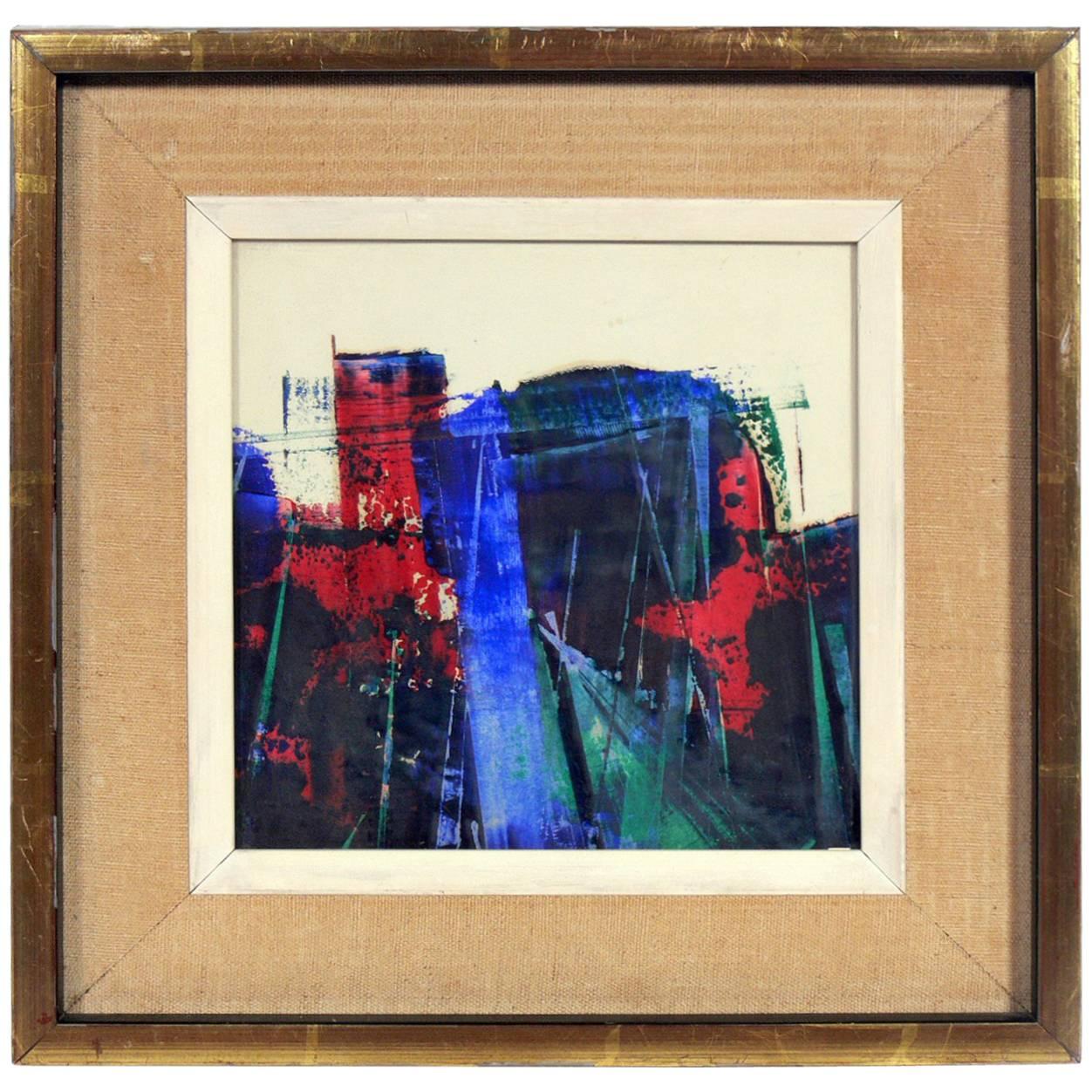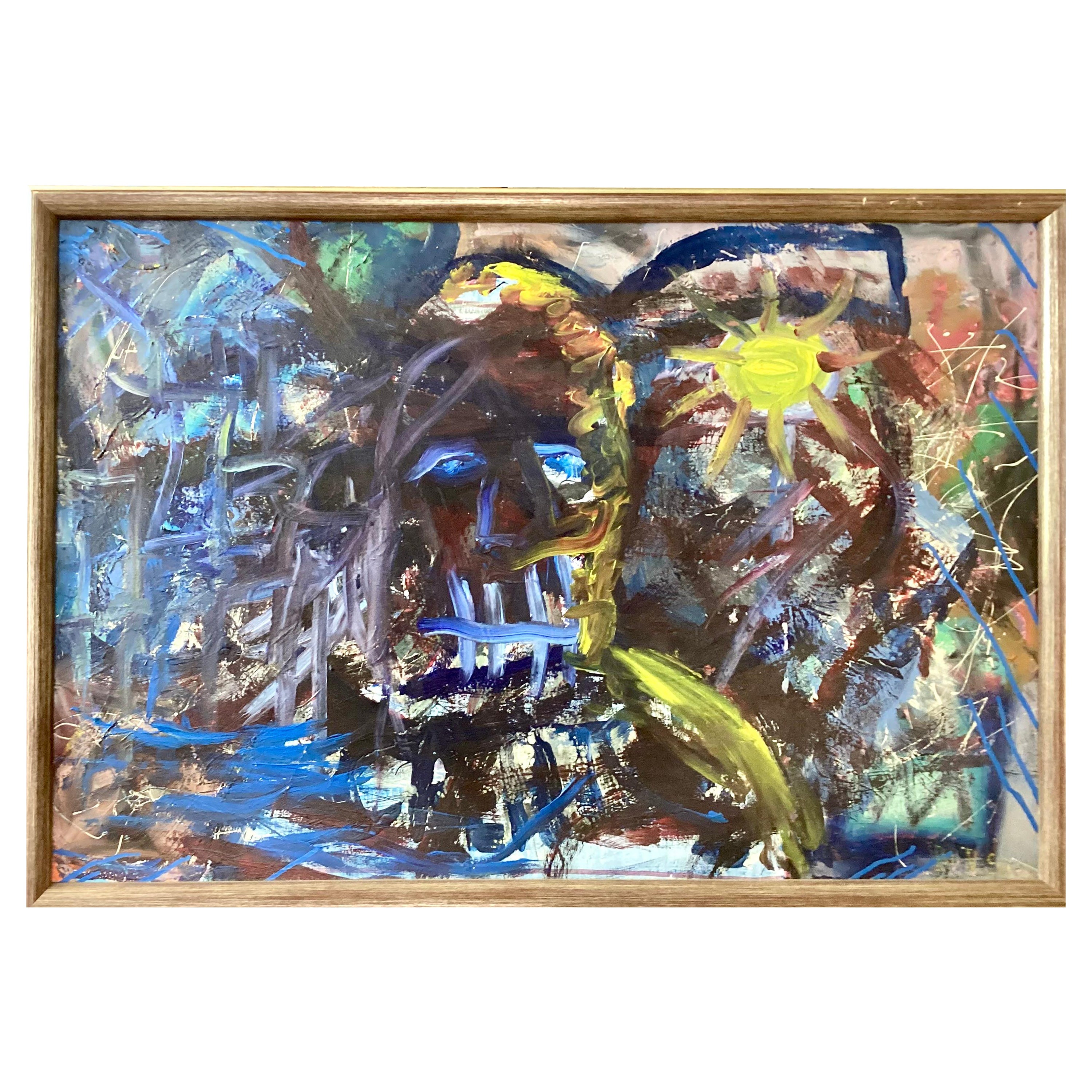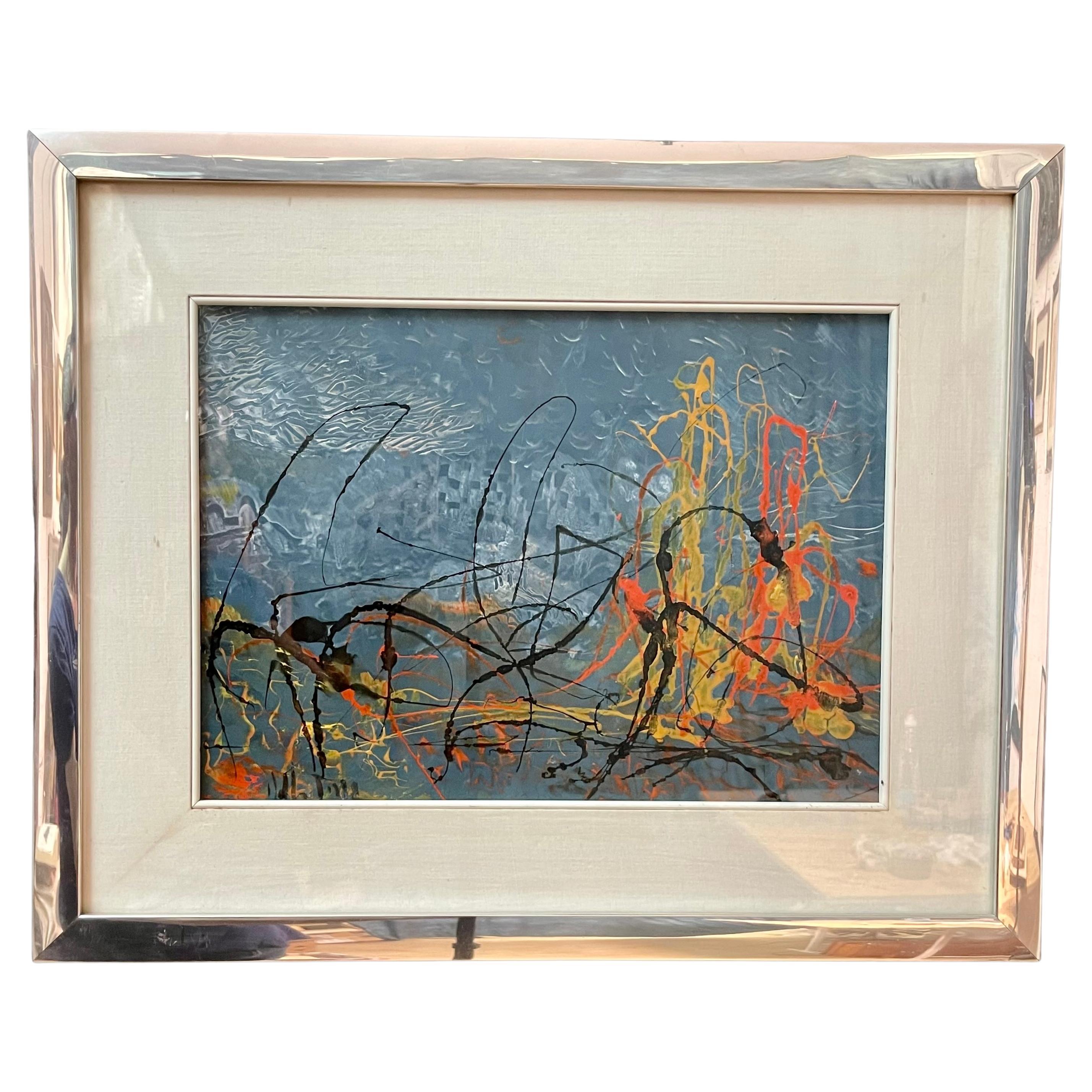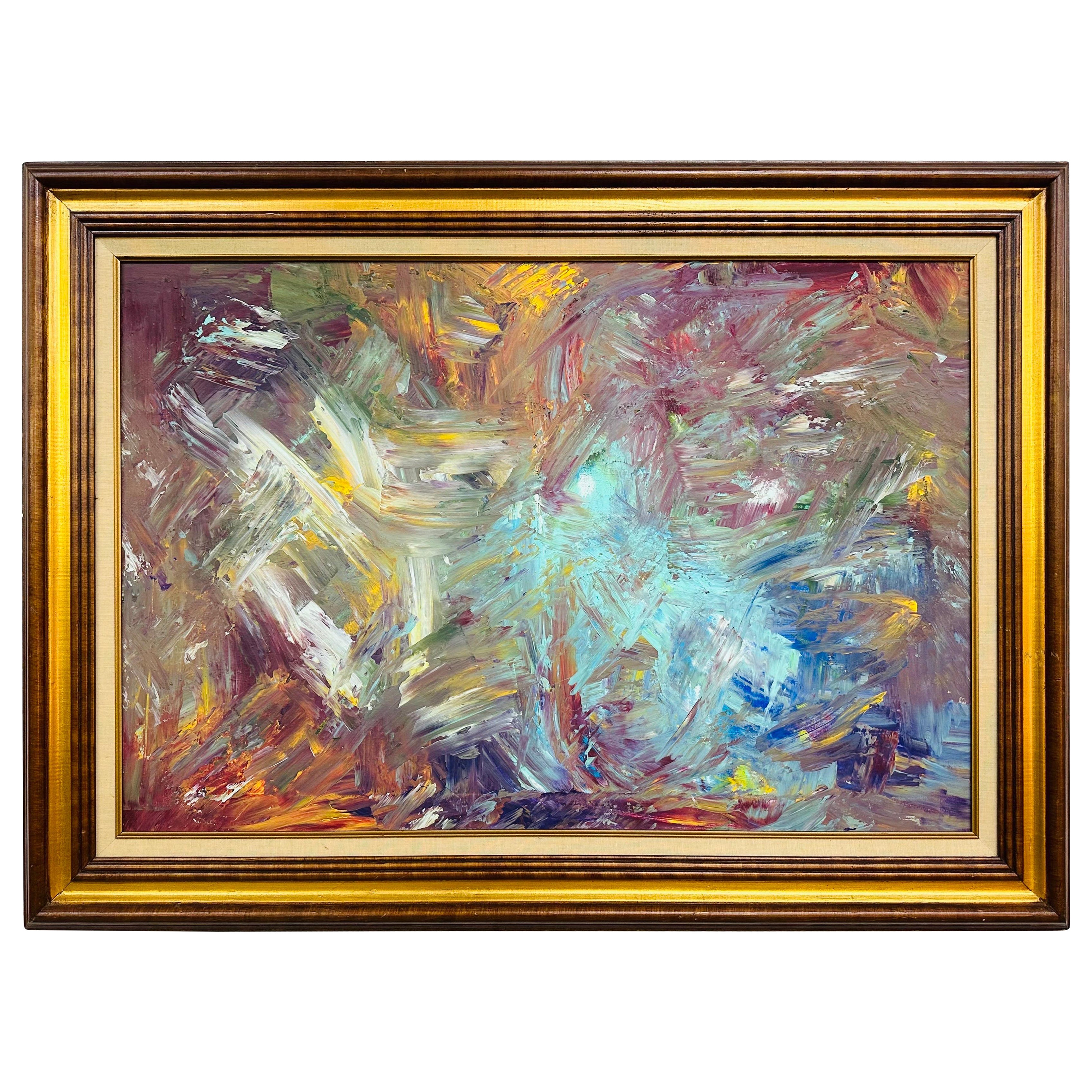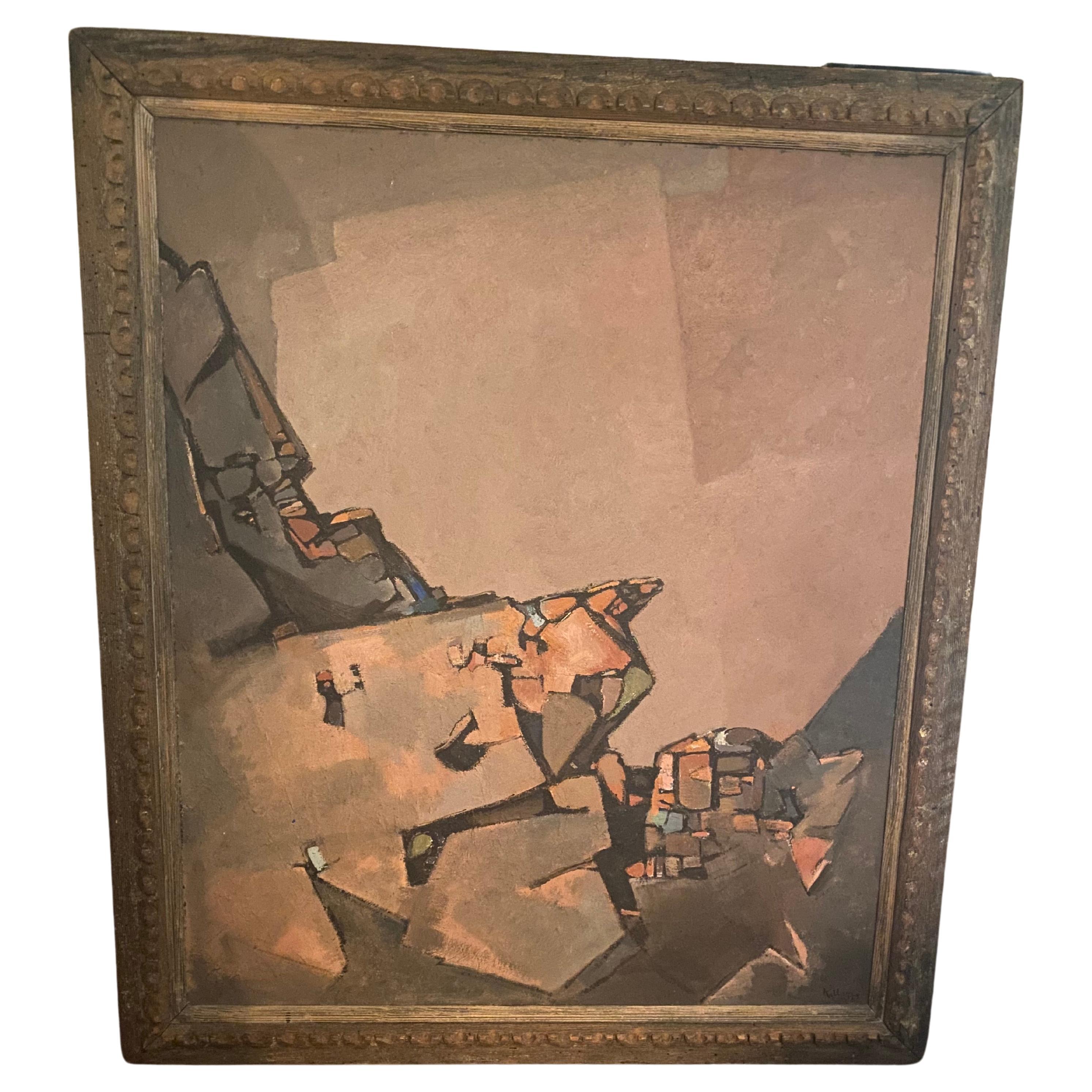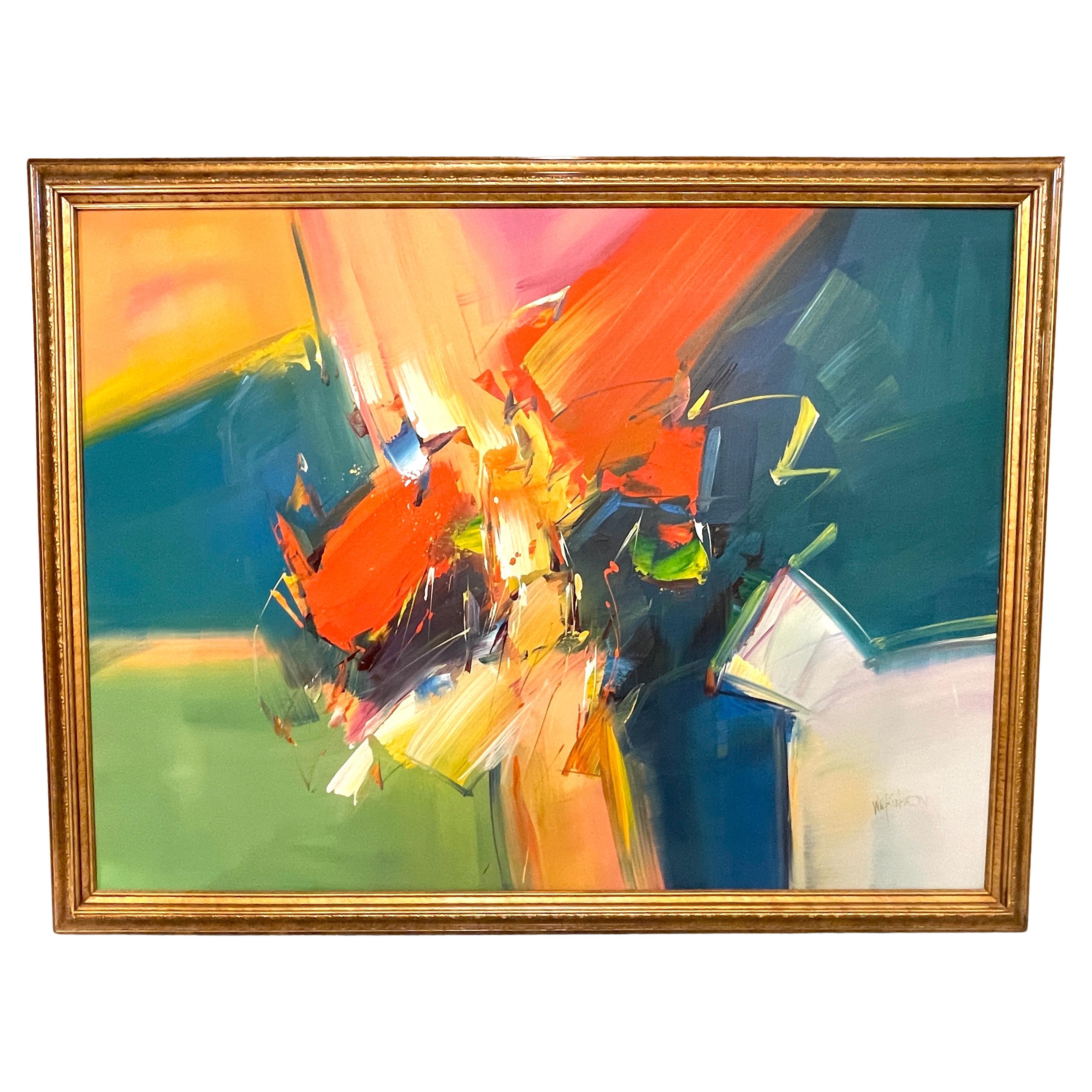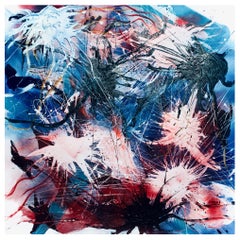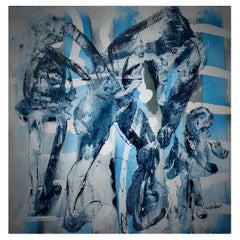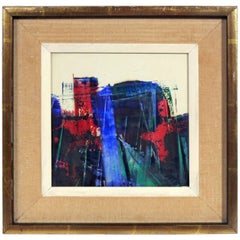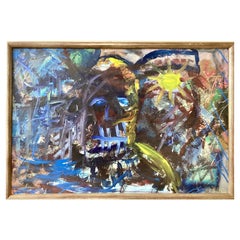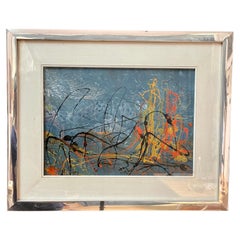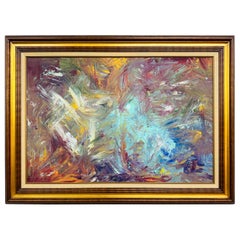Items Similar to Large Modern Abstract Art Painting Signed Original Mark Dickson
Video Loading
Want more images or videos?
Request additional images or videos from the seller
1 of 21
Large Modern Abstract Art Painting Signed Original Mark Dickson
$3,920
$4,90020% Off
£2,958.32
£3,697.9020% Off
€3,386.82
€4,233.5320% Off
CA$5,528.50
CA$6,910.6220% Off
A$6,069.60
A$7,58720% Off
CHF 3,166.52
CHF 3,958.1620% Off
MX$73,450.65
MX$91,813.3120% Off
NOK 39,687.47
NOK 49,609.3420% Off
SEK 37,396.04
SEK 46,745.0420% Off
DKK 25,281.74
DKK 31,602.1820% Off
About the Item
This is an Original Mark Dickson painting and can be described as nothing short of a revelation in the realm of contemporary art. As one navigates through his vibrant interplay of colors—pinks, purples, blues, and greens—it becomes evident that his works are a bridge between abstract expression and a deep-seated Coloradan sensibility.
From afar, the paintings resonate with the raw energy and abstract impulsiveness reminiscent of Adolph Gottlieb or Mark Rothko. However, upon closer introspection, Dickson's canvas unfolds a symphony, harmoniously blending his intuitive understanding of the Colorado landscapes with an almost Rothkoesque play of color and form.
His artistry is a culmination of his academic sojourns, from the bustling art scene of Brooklyn's Pratt Institute to the scholarly corridors of the University of Denver. Yet, what stands out is his capability to transcend these teachings and manifest a unique narrative—one that reflects both the external world and the myriad landscapes of the human psyche.
The choice of medium, notably pastel mixed with watercolors, oil washes, and graphite pencil, demonstrates a tactile indulgence in his craft. It's as if he's chiseling his memories, experiences, and observations of the Coloradan terrains and skies into each canvas.
For the discerning eye, his works might also evoke the expansive color fields of Milton Avery. Yet, Dickson’s approach, particularly his relationship with color, is refreshingly instinctual, almost challenging the viewer to feel rather than dissect.
In Mark Dickson's work, we're treated to an exhilarating dance of abstract brilliance juxtaposed with the tangible and intangible memories of Colorado's landscapes. In a sense, each painting becomes an invitation—to wander, to wonder, and to immerse in the art of profound introspection.
The majority medium is pastel and a mixed media of watercolors, oil washes, and graphite pencil. Color is of primary importance to his work. His work shows the influence of artists Milton Avery(who used large areas of color) and Mark Rothko and Adolph Gottlieb (known for their work in the variations of color). Mark is fascinated with color and explores every aspect of its relationships. He feels his use of color is more intuitive versus analytical.
Mark Dickson’s paintings, prints and monotypes are represented in private, corporate and public art collections nationally.
Pratt Institute, Graduate School of Fine Arts, Brooklyn, New York, 1970
University of Denver, Graduate School of Art, MFA, Denver, Brooklyn, New York, 1973
Denver Art Museum, Colorado Annual, 1967
National Academy of Design, National Audubon Exhibition, New York
Joslin Art Museum Exhibition of Colorado artists, Omaha, Nebraska
Included in Outstanding and Noteworthy Americans, Bicentennial Edition, New York
Chicago Botanical Garden, solo exhibition, North Brook Illinois
Colorado Symphony Orchestra Association, limited-edition lithograph commission
Broadway South West department store Commission; shopping bag and print.
Award of Merit from American Institute of graphic arts, and Award of Distinction: "Creativity 86" Art Direction Magazine, New York
Stables Art Center, Taos New Mexico, Artist of Taos
Who's Who in American Art, 1990, New York
Arts Student's League of Denver, Board of Directors
O'Sullivan Art Center, Regis University solo exhibition, Denver
Britto Central Gallery, solo exhibition, São Paulo Brazil, 2003
Amarillo Art Museum, permanent collection
Amoco Oil Company, Chicago
Federal Reserve Bank, Denver
University of Colorado, permanent collection, Boulder, Colorado
Garnett Corporation headquarters, Arlington Virginia
IBM Corporation Miami Florida
Las Vegas Federal Medical Center
Kirkland Art Museum, permanent collection, Denver
Northern Trust Bank, Naples, Florida
Planes Art Museum, Moorhead, Minnesota
Texaco Oil Corporation, White Plains, New York
Grand Deco Village Hotel, Tokyo Japan
American Airlines terminal, Kennedy International Airport, New York
Taco Bell National headquarters, Santa Fe, New Mexico.
- Attributed to:(after) Mark Rothko (Artist)
- Dimensions:Height: 40.5 in (102.87 cm)Width: 50.25 in (127.64 cm)Depth: 2 in (5.08 cm)
- Materials and Techniques:
- Period:1990-1999
- Date of Manufacture:1991
- Condition:The frame has scratches. The painting is in perfect condition. The site size is 39" x 32".
- Seller Location:New York City, NY
- Reference Number:1stDibs: LU5191132916652
Farrago Design Inc
Farrago Design is a New York–based design studio creating collectible furniture and home accessories that marry craftsmanship with contemporary design. Founded with a mission to revive traditional techniques in a modern context, Farrago works directly with artisans to create heirloom-quality pieces using materials such as hand-carved bone, horn, sand-cast metals, and semi-precious stones. Our work sits at the crossroads of art and function and includes three collections. The Sand Collection features intricately hand-cut bone and horn inlays set into wood and sealed with a water-based resin. The patterns—subtle, organic, and architectural—are fully customizable, making these pieces ideal for bespoke residential and hospitality projects.
The Water Collection explores the sculptural potential of metal, using sand-casting techniques to create fluid, one-of-a-kind forms in Bronze, Aluminum, Brass etc, From side tables to lighting, each piece is cast in a single-use mold, making it truly unique adding texture and movement.
The Earth Collection celebrates the raw beauty of the natural world, incorporating hand-set minerals like pyrite, selenite, and semi-precious stones into bold, luxurious designs. Every piece is made to order and can be customized in scale, material, and finish. We welcome trade inquiries and collaborate closely with designers to develop bespoke products whether for a modern loft, boutique hotel, or superyacht interior.
About the Seller
5.0
Vetted Professional Seller
Every seller passes strict standards for authenticity and reliability
Established in 2003
1stDibs seller since 2020
12 sales on 1stDibs
- ShippingRetrieving quote...Shipping from: New York, NY
- Return Policy
Authenticity Guarantee
In the unlikely event there’s an issue with an item’s authenticity, contact us within 1 year for a full refund. DetailsMoney-Back Guarantee
If your item is not as described, is damaged in transit, or does not arrive, contact us within 7 days for a full refund. Details24-Hour Cancellation
You have a 24-hour grace period in which to reconsider your purchase, with no questions asked.Vetted Professional Sellers
Our world-class sellers must adhere to strict standards for service and quality, maintaining the integrity of our listings.Price-Match Guarantee
If you find that a seller listed the same item for a lower price elsewhere, we’ll match it.Trusted Global Delivery
Our best-in-class carrier network provides specialized shipping options worldwide, including custom delivery.More From This Seller
View AllO/C Mid-Century Abstract Figurative Painting, Signed and Dated
By Wifredo Lam
Located in New York City, NY
This striking mid-century abstract painting depicts a seated dancer rendered in a sophisticated cubist-inspired style reminiscent of Pei Yang's work, though attribution remains uncon...
Category
Mid-20th Century Paintings
Materials
Paint
Mixed Media Painting by Steven Colucci
By John Byard
Located in New York City, NY
Steven Colucci’s iconoclastic approach to performance and the visual arts
have not only long blurred the boundaries between these disciplines, but have
challenged its most basic assumptions. The title of this show references a
most rudimentary dance move --the plié --and our assumptions of what to
expect in relation to this. Also the suggestion that we can simply press a
button and a preconceived outcome will be courteously delivered --a form of
prefabricated belief in itself. Steven Colucci’s artwork turns such basic
assumptions on their heads. Finding early inspiration in the New York school
of abstract expressionists such as Jackson Pollock with his action painting,
and then further by his professor --a then young Vito Acconci while studying
at the School of Visual Arts, Steven Colucci went from exploring the raw
existentialist experimentation of New York’s early painting and performance
scenes, to investigating the other end of the spectrum --the rigorously
measured and controlled disciplines of pantomime and ballet; studying in
Paris under the tutelage of world-famous Marcelle Marceau, and engaging
with the concepts of dramatic movement pioneer and intellectual Etienne
Decroux. Colucci has explained the difference between the extremes of
pantomime and dance as being that pantomime forces movement via an
internal capacity --movement directed inward to the core of one’s self --a
source requiring extreme mental and physical control. Dance by contrast is
an external expression; likewise requiring great precision, although instead
an extension of self or sentiment that projects outwardly. While such
historical ‘movement’ disciplines serve as foundation blocks for Steven’s
artistic explorations, it is the realm in between that he is best known for his
contributions --an experimental movement and performance art that
simultaneously honors, yet defiantly refutes tradition; rejecting a
compartmentalization regarding art and movement, yet incorporating its
elements into his own brand of experimental pastiche. Colucci’s performance
works manifest as eerily candy-coated and familiar, yet incorporate
unexpected jags of the uncanny throughout, exploiting a sort of coulrophobia
in the viewer; an exploration of a cumulative artifice that binds human
nature against its darker tendencies; highlighting traditions of artifice itself -
the fabricated systemologies that necessitate compartmentalization in the
first place.
It is evident in Steven Colucci’s paintings that he has established a uniquely
distinctive pictorial vocabulary; a strong allusion to --or moreso an extension
of --his performance works. Colucci’s paintings depict a sort of kinetic
spectrum, or as he refers to them “a technical expression of physicality and
movement”. Whereas the French performance and visual artist Yves Klein
used the human body as a “paint brush” to demarcate his paintings and
thereby signify a residue of performance, Colucci’s utilization of nonsensical
numbers and number sequences taken from dance scores, as well as heat-
induced image abstraction depicting traces of movement likewise inform his
vocabulary. In the strand of the choreographed, yet incorporating moments of
chance, Colucci’s paintings represent an over arching structure; a rhythm of
being and state, yet detail erratic moments --moments that denote a certain
frailty --the edge of human stamina. Colucci’s paintings dually represent a
form of gestural abstraction --and also the reverse of this --a unique
anthropomorphization of varying states of movement – that sometimes
present as a temperature induced color field, at others are juxtapositions of
movement and depictions of physical gestural images themselves. Colucci’s
use of vernacular and found materials such as cardboard evoke his mastery of
set design, and also reference a sort of collective experience of urbanity and
the ephemeral. Such contradictions seem to permeate not only Steven
Colucci’s artwork, but also are reflected in his person – one who grew up in
New York’s Bronx during a zeitgeist moment in visual and performing arts in
the 1960s – one who shifts with ease from happenings and experiments in
New York City, to his meticulously choreographed megaproductions at
Lincoln Center or starring in the Paris ballet...
Category
2010s Paintings
Materials
Acrylic
Mixed Media Painting by Steven Colucci
By Jackson Pollock
Located in New York City, NY
Steven Colucci’s iconoclastic approach to performance and the visual arts
have not only long blurred the boundaries between these disciplines, but have
challenged its most basic assumptions. The title of this show references a
most rudimentary dance move --the plié --and our assumptions of what to
expect in relation to this. Also the suggestion that we can simply press a
button and a preconceived outcome will be courteously delivered --a form of
prefabricated belief in itself. Steven Colucci’s artwork turns such basic
assumptions on their heads. Finding early inspiration in the New York school
of abstract expressionists such as Jackson Pollock with his action painting,
and then further by his professor --a then young Vito Acconci while studying
at the School of Visual Arts, Steven Colucci went from exploring the raw
existentialist experimentation of New York’s early painting and performance
scenes, to investigating the other end of the spectrum --the rigorously
measured and controlled disciplines of pantomime and ballet; studying in
Paris under the tutelage of world-famous Marcelle Marceau, and engaging
with the concepts of dramatic movement pioneer and intellectual Etienne
Decroux. Colucci has explained the difference between the extremes of
pantomime and dance as being that pantomime forces movement via an
internal capacity --movement directed inward to the core of one’s self --a
source requiring extreme mental and physical control. Dance by contrast is
an external expression; likewise requiring great precision, although instead
an extension of self or sentiment that projects outwardly. While such
historical ‘movement’ disciplines serve as foundation blocks for Steven’s
artistic explorations, it is the realm in between that he is best known for his
contributions --an experimental movement and performance art that
simultaneously honors, yet defiantly refutes tradition; rejecting a
compartmentalization regarding art and movement, yet incorporating its
elements into his own brand of experimental pastiche. Colucci’s performance
works manifest as eerily candy-coated and familiar, yet incorporate
unexpected jags of the uncanny throughout, exploiting a sort of coulrophobia
in the viewer; an exploration of a cumulative artifice that binds human
nature against its darker tendencies; highlighting traditions of artifice itself -
the fabricated systemologies that necessitate compartmentalization in the
first place.
It is evident in Steven Colucci’s paintings that he has established a uniquely
distinctive pictorial vocabulary; a strong allusion to --or moreso an extension
of --his performance works. Colucci’s paintings depict a sort of kinetic
spectrum, or as he refers to them “a technical expression of physicality and
movement”. Whereas the French performance and visual artist Yves Klein
used the human body as a “paint brush” to demarcate his paintings and
thereby signify a residue of performance, Colucci’s utilization of nonsensical
numbers and number sequences taken from dance scores, as well as heat-
induced image abstraction depicting traces of movement likewise inform his
vocabulary. In the strand of the choreographed, yet incorporating moments of
chance, Colucci’s paintings represent an over arching structure; a rhythm of
being and state, yet detail erratic moments --moments that denote a certain
frailty --the edge of human stamina. Colucci’s paintings dually represent a
form of gestural abstraction --and also the reverse of this --a unique
anthropomorphization of varying states of movement – that sometimes
present as a temperature induced color field, at others are juxtapositions of
movement and depictions of physical gestural images themselves. Colucci’s
use of vernacular and found materials such as cardboard evoke his mastery of
set design, and also reference a sort of collective experience of urbanity and
the ephemeral. Such contradictions seem to permeate not only Steven
Colucci’s artwork, but also are reflected in his person – one who grew up in
New York’s Bronx during a zeitgeist moment in visual and performing arts in
the 1960s – one who shifts with ease from happenings and experiments in
New York City, to his meticulously choreographed megaproductions at
Lincoln Center or starring in the Paris ballet...
Category
2010s Paintings
Materials
Acrylic
Mixed Media Painting by Steven Colucci, Sea Series
By Jackson Pollock
Located in New York City, NY
Steven Colucci’s iconoclastic approach to performance and the visual arts have not only long blurred the boundaries between these disciplines, but have challenged its most basic assumptions. The title of this show references a most rudimentary dance move -- the plié -- and our assumptions of what to expect in relation to this. Also the suggestion that we can simply press a button and a preconceived outcome will be courteously delivered -- a form of prefabricated belief in itself. Steven Colucci’s artwork turns such basic assumptions on their heads. Finding early inspiration in the New York school of abstract expressionists such as Jackson Pollock with his action painting, and then further by his professor -- a then young Vito Acconci while studying at the School
of Visual Arts, Steven Colucci went from exploring the raw existentialist experimentation of New York’s early painting and performance scenes, to investigating the other end of the spectrum -- the rigorously measured and controlled disciplines of pantomime and ballet; studying in Paris under the tutelage of world-famous Marcelle Marceau, and engaging with the concepts of dramatic movement pioneer and intellectual Etienne Decroux. Colucci has explained the difference between the extremes of pantomime and dance as being that pantomime forces movement via an internal capacity -- movement directed inward to the core of one’s self -- a source requiring extreme mental and physical control. Dance by contrast is an external expression; likewise requiring great precision, although instead an extension of self or sentiment that projects outwardly. While such historical ‘movement’ disciplines serve as foundation blocks for Steven’s artistic explorations, it is the realm in between that he is best known for his contributions -- an experimental movement and performance art that simultaneously honors, yet defiantly refutes tradition; rejecting a compartmentalization regarding art and movement, yet incorporating its elements into his own brand of experimental pastiche. Colucci’s performance works manifest
as eerily candy-coated and familiar, yet incorporate unexpected jags of the uncanny throughout, exploiting a sort of coulrophobia in the viewer; an exploration of a cumulative artifice that binds human nature against its darker tendencies; highlighting traditions of artifice itself -- the fabricated systemologies that necessitate compartmentalization in the first place.
It is evident in Steven Colucci’s paintings that he has established a uniquely distinctive pictorial vocabulary; a strong allusion to -- or moreso an extension of -- his performance works. Colucci’s paintings depict a sort of kinetic spectrum, or as he refers to them “a technical expression of physicality and movement”. Whereas the French performance and visual artist Yves Klein used the human body as a “paint brush” to demarcate his paintings and thereby signify a residue of performance, Colucci’s utilization of nonsensical numbers and number sequences taken from dance scores, as well as heat-induced image abstraction depicting traces of movement likewise inform his vocabulary. In the strand of the choreographed, yet incorporating moments of chance, Colucci’s paintings represent an over arching structure; a rhythm of being and state, yet detail erratic moments -- moments that
denote a certain frailty -- the edge of human stamina. Colucci’s paintings dually represent a form of gestural abstraction -- and also the reverse of this -- a unique anthropomorphization of varying states of movement -- that sometimes present as a temperature induced color field, at others are juxtapositions of movement and depictions of physical gestural images themselves. Colucci’s use of vernacular and found materials such as cardboard evoke his mastery of set design, and also reference a sort of collective experience of urbanity and the ephemeral. Such contradictions seem to permeate not only Steven Colucci’s artwork, but also are reflected in his person -- one
who grew up in New York’s Bronx during a zeitgeist moment in visual and performing arts in the 1960s -- one who shifts with ease from happenings and experiments in New York City, to his meticulously choreographed megaproductions at Lincoln Center or starring in the Paris ballet...
Category
2010s Paintings
Materials
Acrylic
Signed color aquatint, etching, carborundum, and collage by James Coignard
Located in New York City, NY
This dynamic mixed-media by James Coignard, exemplifies the artist’s innovative approach to abstraction. A perfect fusion of color aquatint, etching, carborundum, and collage, the pi...
Category
Vintage 1970s Paintings
Materials
Thread, Paper
Mixed Media Painting by Steven Colucci- My eyes on you
By Andrzej Galek
Located in New York City, NY
Steven Colucci’s iconoclastic approach to performance and the visual arts
have not only long blurred the boundaries between these disciplines, but have
challenged its most basic assumptions. The title of this show references a
most rudimentary dance move --the plié --and our assumptions of what to
expect in relation to this. Also the suggestion that we can simply press a
button and a preconceived outcome will be courteously delivered --a form of
prefabricated belief in itself. Steven Colucci’s artwork turns such basic
assumptions on their heads. Finding early inspiration in the New York school
of abstract expressionists such as Jackson Pollock with his action painting,
and then further by his professor --a then young Vito Acconci while studying
at the School of Visual Arts, Steven Colucci went from exploring the raw
existentialist experimentation of New York’s early painting and performance
scenes, to investigating the other end of the spectrum --the rigorously
measured and controlled disciplines of pantomime and ballet; studying in
Paris under the tutelage of world-famous Marcelle Marceau, and engaging
with the concepts of dramatic movement pioneer and intellectual Etienne
Decroux. Colucci has explained the difference between the extremes of
pantomime and dance as being that pantomime forces movement via an
internal capacity --movement directed inward to the core of one’s self --a
source requiring extreme mental and physical control. Dance by contrast is
an external expression; likewise requiring great precision, although instead
an extension of self or sentiment that projects outwardly. While such
historical ‘movement’ disciplines serve as foundation blocks for Steven’s
artistic explorations, it is the realm in between that he is best known for his
contributions --an experimental movement and performance art that
simultaneously honors, yet defiantly refutes tradition; rejecting a
compartmentalization regarding art and movement, yet incorporating its
elements into his own brand of experimental pastiche. Colucci’s performance
works manifest as eerily candy-coated and familiar, yet incorporate
unexpected jags of the uncanny throughout, exploiting a sort of coulrophobia
in the viewer; an exploration of a cumulative artifice that binds human
nature against its darker tendencies; highlighting traditions of artifice itself -
the fabricated systemologies that necessitate compartmentalization in the
first place.
It is evident in Steven Colucci’s paintings that he has established a uniquely
distinctive pictorial vocabulary; a strong allusion to --or moreso an extension
of --his performance works. Colucci’s paintings depict a sort of kinetic
spectrum, or as he refers to them “a technical expression of physicality and
movement”. Whereas the French performance and visual artist Yves Klein
used the human body as a “paint brush” to demarcate his paintings and
thereby signify a residue of performance, Colucci’s utilization of nonsensical
numbers and number sequences taken from dance scores, as well as heat-
induced image abstraction depicting traces of movement likewise inform his
vocabulary. In the strand of the choreographed, yet incorporating moments of
chance, Colucci’s paintings represent an over arching structure; a rhythm of
being and state, yet detail erratic moments --moments that denote a certain
frailty --the edge of human stamina. Colucci’s paintings dually represent a
form of gestural abstraction --and also the reverse of this --a unique
anthropomorphization of varying states of movement – that sometimes
present as a temperature induced color field, at others are juxtapositions of
movement and depictions of physical gestural images themselves. Colucci’s
use of vernacular and found materials such as cardboard evoke his mastery of
set design, and also reference a sort of collective experience of urbanity and
the ephemeral. Such contradictions seem to permeate not only Steven
Colucci’s artwork, but also are reflected in his person – one who grew up in
New York’s Bronx during a zeitgeist moment in visual and performing arts in
the 1960s – one who shifts with ease from happenings and experiments in
New York City, to his meticulously choreographed megaproductions at
Lincoln Center or starring in the Paris ballet...
Category
2010s Paintings
Materials
Acrylic
You May Also Like
Modern Abstract Painting
Located in Atlanta, GA
Modern abstract painting. Dated 1962 and signed illegibly on verso. Retains original gilt and painted wood frame and linen mounting. Size noted below i...
Category
Vintage 1960s American Mid-Century Modern Paintings
Materials
Wood, Paint
$550 Sale Price
35% Off
20th Century Oil on Canvas Abstract Painting
Located in Bradenton, FL
Large 20th century oil on canvas abstract painting. Rich blues, yellows, pinks. Signature in right lower corner, yet unable to decipher.
Category
20th Century American Mid-Century Modern Paintings
Materials
Canvas
Contemporary Abstract Georges Mathieu Style Painting
By Georges Mathieu
Located in Roma, IT
Very interesting French painting in the style of the important artist Georges Mathieu
Oli on panel
Signed at lower left
This painting, never before on the market, comes from a private collection and is beautified by an impressive modern frame in silvered metal, in almost perfect condition.
The painting is also protected by glass
Unframed dimensions cm 35.5 x 26
Georges Mathieu (27 January 1921 – 10 June 2012) was a French abstract painter...
Category
Vintage 1970s French Modern Paintings
Materials
Metal
$794 Sale Price
40% Off
Modern Expressionist Abstract Painting Signed Mullin
Located in Clarksboro, NJ
This listing is for a Modern Expressionist Abstract Painting. Featuring a vintage gold frame, original expressionist style abstract art with a mixture of colors, and a wire on the ba...
Category
21st Century and Contemporary American Mid-Century Modern Paintings
Materials
Canvas, Paint
$396 Sale Price
20% Off
Large Abstract Painting by Walt Killam
Located in Hopewell, NJ
Walt Killam, large oil on Masonite, 1955
(1907-1979), Abstract Landscape, signed and dated lower right, 44"h x 37"w
52"h x 44"w (framed)
Walt Killam was born in Providence, Rhode...
Category
Vintage 1950s American Modern Paintings
Materials
Masonite
$1,750 Sale Price
50% Off
Untitled, Large Abstract by Mandy Wilkinson, British B. 1970
Located in West Palm Beach, FL
Untitled, Large Abstract by Mandy Wilkinson, British B. 1970
Mandy Wilkinson, British 1970
Oil on canvas, 49 inches wide by 36 inches high
Giltwood Fra...
Category
Late 20th Century English Modern Paintings
Materials
Canvas, Giltwood
$2,360 Sale Price
20% Off
More Ways To Browse
Rothko Original
Bruce Sargent
Bruno Chavanne
Bruno Di Giulio
Cannery Row Painting
Carl V Meyer
Carole Battle
Caroline Burnett On Sale
Caroline C Burnett
Carolyn Shine
Cary Leibowitz
Charles Frechon
Chelsea House Oil Painting
Chelsea House Painting
Chinoiserie Diptych
Chris Di Vincente Painting
Chris Di Vincente
Christopher Shearer
